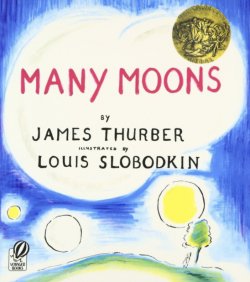Gareth B. Matthews

Review of Many Moons by James Thurber (New York: Harcourt Brace & Co., 1990). Originally published in Thinking: The Journal of Philosophy for Children 15(3): 1.
Princess Lenore falls ill of a surfeit of raspberry tarts. The King promises his daughter anything her heart desires and the Princess announces that what she wants is the moon. “If I can have the moon,” she says simply, “I will be well again.”
The King summons the Lord High Chamberlain and demands that he get the moon for the Princess. The Lord High Chamberlain makes a wonderfully eccentric and whimsical speech that ends with the admission that, alas! he cannot get the moon for the Princess. “Blue poodles, yes; the moon, no.”
On hearing this, the King flies into a rage and then tells the Lord High Chamberlain to send for the Royal Wizard. He, it turns out, thinks the moon is “150,000 miles away, and it is made of green cheese, and it is twice as big as this palace.”
At that the king flies into rage and sends for the Royal Mathematician, who does no better at satisfying the King’s demand. So, the King flies into yet another rage and then rings for the Court Jester. In despair the King tells the Jester his troubles and asks him to play on his lute, “something sad.”
The Court Jester, cleverly, suggests to the King that they find out how big the Princess Lenore thinks the moon is, and how far away. With this thought the Court Jester creeps softly into the little girl’s room.
“Have you brought the moon to me?” asks the Princess Lenore.
“Not yet,” admits the Jester, “but I will get it for you.” He then asks the little girl how big she thinks the moon is, and how far away.
“It’s just a little smaller than my thumbnail,” the girl answers, “for when I hold my thumbnail up at the moon, it just covers it.” She adds that the moon is not as high as the big tree outside my window, since it gets caught in the top branches.
The Court Jester then gets the Royal Goldsmith to make a tiny round golden moon, just a little smaller than Princess Lenore’s thumbnail. The Court Jester takes this moon to the Princess, who is overjoyed. The next day she is well again.
Unfortunately, the King’s worries are not over. He is now afraid that the Princess will see the moon in the sky again that night and realize that she doesn’t have the moon on a golden chain around her neck after all. ‘We must hide the moon,” he exclaims.
The King’s courtiers suggest making dark glasses for the Princess, or covering the palace with a tent, or setting off fireworks so that the moon cannot be seen. The King finds drawbacks to each of these plans and again falls into a rage. Again, the Court Jester offers to help. He returns to the Princess’s room and asks, mournfully, “How can the moon be shining in the sky when it is hanging on the golden chain around your neck?”
“That’s easy, silly,” she says; “when I lose a tooth, a new one grows in its place, and when the unicorn loses his horn in the forest, a new one grows in the middle of his forehead.” She adds, “It is the same way with the moon. “The Jester tucks the covers around the Princess, who goes to sleep.
The moon is the most mysterious of the heavenly bodies. Yet in the zombie-like way most of us adults go through life, we have shut our eyes to its seductive secrets. We need to talk to our children and learn from them how to see the moon with fresh eyes.
Some philosophers have liked to think that what we know is somehow based on the data of our sense experience, plus reasoning about those data. So, forget the fact that there is a long article on the moon in your home encyclopedia. Just look out for the moon during the next month or two. What could you figure out about the moon, just from observing it?
Perhaps we would understand only very little. For starters, there are the different phases that need to be observed and then figured out. Sometimes a very new moon looks like the illuminated edge of a dark ball, what the poets have called, “the new moon with the old moon in its arms.” But usually the moon in its non-full phases looks more like a wedge, or sliver, or a deformed disk.
And that is only the beginning. There is the man-in the-moon to think about. And there is the “paper moon” to take into account. I can remember seeing a beautiful paper moon on a hot summer’s evening, “pasted on the sky” as the Royal Mathematician in Thurber’s story puts it, across the water from me and over the golden State House dome in Boston. It was an unforgettable sight!
My all-time favorite illusion is, in fact, the “moon illusion,” the fact that the moon looks much bigger on the horizon than it does up high in the sky. We get terrific moon illusions where I live. I love them. And I like to reflect on the fact that there are almost ninety different explanations of that phenomenon. No single one is universally accepted.
So, what could we figure out about the moon just by looking? That’s an especially fun question to consider with children, either at home or in school. And Thurber’s story is a delightful goad to inquiry.
